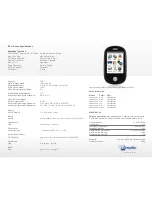
5
What is a “Music Server”?
SoundBridge is a network music player. That is, it doesn’t store any music, but plays files that
you have stored on a computer connected to your home network. (It can also play Internet
radio without connecting to your computer, using a direct connection to the Internet.) To play
the music files stored on your computer, SoundBridge needs to receive data from software
installed on the computer that “serves” the music. This “music server” is responsible for
streaming the music to SoundBridge. It is also responsible for sending the list of music you
have available to SoundBridge (when asked), and performing searches of the music library at
SoundBridge’s request.
You probably already have a music server but perhaps didn’t realize it. For example, iTunes acts
as a music server when it shares music to another iTunes user on the network. Microsoft has
released its own music server, Windows Media Connect.
The most common music servers are iTunes, Windows Media Connect, and Rhapsody. But there
are others. If you want to use a Microsoft PlaysForSure music service, you must use Windows
Media Connect. If you want to use the Rhapsody music service, you currently must use
Rhapsody as your music server. One of the benefits of SoundBridge is that it supports all the
common servers out there with an easy-to-use interface.
Note:
For playing back Internet radio using SoundBridge’s “Radio Favorites” library, you don’t
need a music server, because SoundBridge receives the radio stream directly from the Internet.
SoundBridge Has Two Ui Modes
Each music server has different capabilities. To experience the full SoundBridge user interface,
which includes searching and robust browsing modes, you must use a server that supports
these functions, such as iTunes or Windows Media Connect. Some other servers don’t have the
functionality required to deliver the full SoundBridge feature set. For example, you won’t be
able to search, and the browse modes will vary by server.
1
Section 1:
Getting Started







































